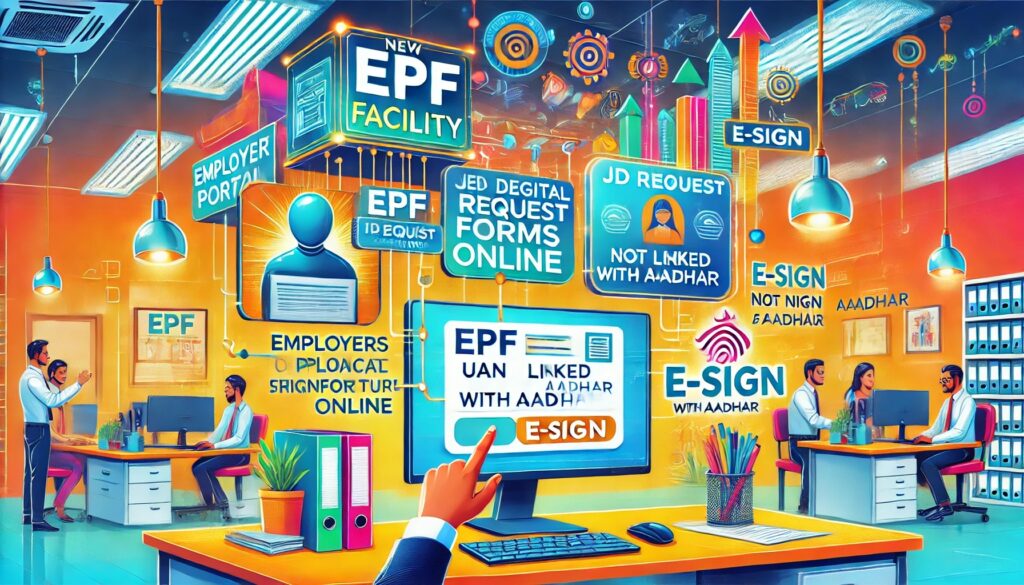The Employees’ Provident Fund (EPF) has introduced a new facility aimed at simplifying the process for employers to submit Joint Declaration (JD) requests. This development is particularly beneficial for those members whose Universal Account Numbers (UANs) are not linked with Aadhar or for those who face difficulties accessing the Member E-SEWA portal. This article delves into the intricacies of this new facility, highlighting its benefits, requirements, and the step-by-step process for employers to leverage this feature.
Understanding the New EPF Facility
The new EPF facility allows registered employers to initiate online JD requests by uploading the required request forms and documents. These forms and documents must be duly signed and submitted by the EPF members. This facility is a significant step forward in digitalizing the EPF processes, reducing the dependency on physical forms, and streamlining the workflow for both employers and employees.
Who Can Benefit from This Facility?
This facility is specifically designed for:
- UANs Not Linked with Aadhar: Members whose UANs are not linked with their Aadhar can use this facility to submit their JD requests.
- Members Unable to Access Member E-SEWA Portal: This includes members who face technical or access issues with the Member E-SEWA portal.
By addressing these two categories, the EPF ensures that more members can conveniently manage their accounts without the need for physical documentation.
Key Requirements for Employers
To use this facility, employers must meet certain requirements:
- EPF Registration: Employers must be registered with the EPF.
- Active E-Sign: Employers need an active E-Sign to authenticate and submit the documents online. The E-Signature ensures that the submissions are legally valid and secure.
- Access to Employer Portal: Employers must have access to the EPF Employer Portal where this facility is available.
Step-by-Step Guide to Using the New Facility
- Login to the Employer Portal: Employers must log in to the EPF Employer Portal using their credentials.
- Navigate to JD Request Section: Once logged in, navigate to the section where JD requests can be initiated.
- Upload Required Documents: Upload the request forms and documents as per the Standard Operating Procedure (SOP) laid down by EPFO. Ensure that all documents are duly signed by both the EPF members and the employer. If any document is not signed by either the member or the employer, the submission will be rejected.
- Authenticate Using E-Sign: Use your active E-Sign to authenticate the documents. This step is crucial as it ensures the legal validity of the submission.
- Submit the Request: After authentication, submit the JD request. The system will provide a confirmation receipt for the submission, which can be used for future reference.
Advantages of the New EPF Facility
The new EPF facility offers several advantages:
- Convenience: The ability to submit JD requests online eliminates the need for physical forms, making the process more convenient for employers and employees alike.
- Time-Saving: Digital submissions are faster and reduce the time taken to process JD requests.
- Accessibility: Members who cannot access the Member E-SEWA portal or whose UANs are not linked with Aadhar can still manage their EPF accounts effectively.
- Security: The use of E-Sign ensures that submissions are secure and legally binding.
Conclusion
The new EPF facility for initiating online JD requests is a significant step towards digitalization and efficiency in the management of EPF accounts. By understanding the requirements and following the outlined steps, employers can leverage this facility to streamline their processes and provide better service to their employees. This initiative not only enhances the convenience for employers but also ensures that all EPF members can manage their accounts seamlessly, regardless of their ability to access the Member E-SEWA portal or link their UAN with Aadhar.
For any further assistance or queries regarding the new EPF facility, employers are encouraged to contact the EPF helpdesk or refer to the detailed guidelines available on the EPF Employer Portal.





